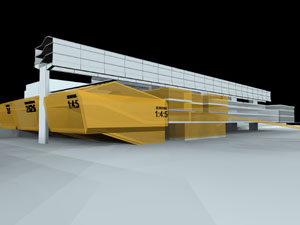
"LOOK AT THAT!" shrieks loudmouth TV presenter/gob-for-hire Janet Street-Porter, as she approaches what passes for the town centre of Cumbernauld in Scotland. Later on, in a rare quieter moment, she admits that when she studied architecture in the Sixties this would have been the kind of thing she designed.
Welcome to Channel 4's Demolition program about Cumbernauld Town Centre in Scotland, voted the worst building in Britain. But is it really that bad, or just a victim of shifting architectural fashions?
Of course, most disurbanist projects and utopian socialist experiments fall firmly into the Megaproject category, overblown architectural and enviromental projects as well as social engineering schemes and economic sink holes. Cumbernauld's creators certainly had the vision-thing going on.
As described on Gair Dunlops excellent site Cumberland: Town for Tomorrow:
'Conceived as a giant megastructure to accommodate all the retail, municipal, and leisure needs of a town of 50,000 people, and topped off by penthouse 'executive' apartments, the multi-layered centre straddles the main dual carriageway below, dominating its surroundings. With the completion of the first phase in 1967, the town centre's architect, Geoffrey Copcutt, gave Cumbernauld Britain's first indoor shopping mall, and "the fullest realisation of megastructure as an avant-garde urbanist conception."'
Inevitably, the scheme was never fully built as intended, and the shortcuts and cut-backs led to a compromised, flawed megastructure. But having delivered a half-baked distopian nightmare, with badly constructed concrete maze, derided as a "rabbit warren on stilts", the planners of Cumbernauld compounded the problem by selling off the centre to a private company, who then demolished half the centre, leaving it beached on a sea of rubble. The council then allowed the area beyond it's perimeter to be developed as a series of big box retail outlets, contrasting the streets-in-the-air concept of the rest of Cumbernauld with purely ground-level circulation (as previously noted Wal-Mart, the leaders in big-box retail, like the Daleks or Mariah Carey, don't do stairs). More polar opposed approaches to urbanism would be hard to find.
Main presenter and Kevin McCloud briefly points the finger at the banal tin shed of the giant Tesco's (in a rare moment of role-playing he imagines he's just done his shopping and needs to catch a bus) before attempting to cross the 4-lane highway that races through Cumbernauld, via the shopping centre.
"Uh-oh, some lads in hoodies, lurking down there" warns McCloud, going the other way, and inevitably getting horribly lost inside the maze of stairs and spaces. But given that there are no signs or maps, this is hardly surprising. Would his experience have been any better at Bluewater, visited later in the program and lauded as the right-way to do a shopping centre, with it's panopaly of psychological devices. Perhaps in 30 years time, Janet Street-Porter can wail "WHAT WERE THEY THINKING?" about Bluewater or The Trafford Centre instead.
Even desolate Cumbernauld, despite 'winning' the Channel 4 Demolition vote as Britain's worst building (not to mention coming 2nd in the Idler book of Crap Towns - beaten only by Hull) has it's defendants, and has been awarded a UNESCO listing as an architecturally significant 20th century landmark, and not because Gregory's Girl was filmed there. McCloud and a rag-tag team of professionals attempt a quick design appraisal, but this is going to take more than a Changing Rooms makeover.
Demolition, in focussing only upon the failures of the 60's shopping centre, goes for the easy target, and fails to address the equally heinous failings of the 90's tin sheds, which litter not just Cumbernauld but the hinterlands of just about every town in Britain. In throwing out the bathwater of Brutalism we seem to have also lost the baby of visionary thinking.
[First posted Dec 23, 2005]
